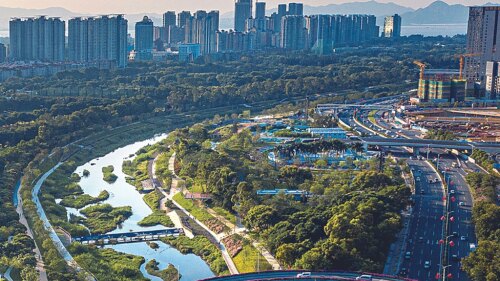
From left to right: Jon Zehner, global cohead, client capital group, LaSalle Investment Management, London; Calvin Gladney, managing partner, Mosaic Urban Partners, Washington, D.C.; Jonathan Brinsden, chief executive officer, Midway, Houston; Philip Payne, chief executive officer, Ginkgo Residential, Charlotte, North Carolina; Teri Frankiewicz, vice president of community development, Crown Community Development, Naperville, Illinois; and Randall Rowe, ULI global chairman and chairman of Green Courte Partners in Chicago.
The significant, lasting impact that driverless technology will have on land use and urban development was the topic of a thought-provoking discussion at ULI’s recent Midwinter Meeting, held at ULI headquarters in Washington, D.C., and attended by the Institute’s global trustees.
Dave Bragg, managing director, residential, at Green Street Advisors in Newport Beach, California, kicked off the session with an overview of the status of autonomous transportation technology. He predicted that self-driving automobiles could be prevalent in many U.S. urban areas within ten years, although he noted that some in the tech industry claim the timing could be closer to five years. Of the many technology-driven disruptors, the transportation revolution—including ride sharing, driverless cars, and driverless ride sharing—has the most potential as a “game changer for real estate,” he said.
From ULI Connect: ULI Global Chairman Randy Rowe on the Transportation Revolution | ULI Member-Led Group Explores Autonomous Vehicles’ Impact on Real Estate
Bragg cited several likely impacts of driverless technology:
- Reuse of parking space. Tens of billions of square feet of unused parking space could result from a dramatic decline in individual vehicle ownership, opening up opportunities for redevelopment as commercial or residential space. Self-storage facilities could be hurt as more people use empty garages to store their property.
- Repricing of properties. The potential for reuse of existing parking space could affect the pricing of existing developments that now provide ample surface parking or garage facilities.
- Rethinking of mass transit. The need for mass transit could be diminished as use of autonomous cars increases. In addition, the premium placed on living and working near mass transit could be reduced.
- A shift in suburban and urban dynamics. Commuting from the suburbs to the workplace could become less cumbersome—cheaper and more convenient. As a result, suburban living could be more appealing for many households that might otherwise have sought to live in close-in urban neighborhoods. In addition, the technology could help level the playing field in terms of property values in the exurbs versus those in urban cores.
- Job losses among those who drive for a living. Driverless technology could eliminate the need for delivery truck drivers, taxi drivers, and others who earn a living by driving—a group currently accounting for about 3 million U.S. workers.
- Fewer reasons to make store visits. Driverless cars could run and combine errands more efficiently than humans, causing low-quality retail businesses such as convenience stores to suffer. Specialty retailers that serve as destinations people want to visit would continue to perform well.
- A boost for central business district office space. Faster, hassle-free commutes could make such office space more desirable and reduce the need for telecommuting.
Randall Rowe, ULI global chairman and chairman of Green Courte Partners in Chicago, who moderated a response panel of trustees, pointed out that issues related to liability and protocol must be addressed in order for driverless technology to be widely adopted. In addition, he noted that local governments will need to rethink infrastructure investments in terms of funding “smart” infrastructure to accommodate autos that start, stop, accelerate, decelerate, navigate, and park themselves.
The panelists speculated on a variety of potential outcomes, such as whether broad access to driverless cars would cause neighborhoods in urban regions to become more diverse or more homogeneous; whether the technology might lead to more sprawl or more density; whether it would benefit underserved areas or further drain them; and how broadly it would be used outside urban areas other than for goods distribution.
The consensus: though the unknowns still outweigh the knowns, the switch from human-operated vehicles to driverless ones will be just as transformative for 21st-century urban design and development as the switch from horse-drawn carriages to cars was in the 20th century.
“Cars have emerged from being a mechanical appliance to a computer-driven appliance, but what they have yet to become is a network appliance, and that is what autonomous cars will be,” observed Jonathan Brinsden, chief executive officer, Midway, Houston. “The implications of that are massive from an investment standpoint and a social standpoint.”
Also taking part in the panel were Teri Frankiewicz, vice president of community development, Crown Community Development, Naperville, Illinois; Calvin Gladney, managing partner, Mosaic Urban Partners, Washington, D.C.; Philip Payne, chief executive officer, Ginkgo Residential, Charlotte, North Carolina; and Jon Zehner, global cohead, client capital group, LaSalle Investment Management, London.
(Rowe was also recently featured in a Forbes.com article exploring the implications of autonomous vehicle technology.)





